With an impressive 9:0 victory on the final matchday of the second Austrian division, Ried managed to finish in the first position and therefore get promoted to the Austrian Bundesliga. Even though there were several problems within the club, the team of head coach Gerald Baumgartner managed to find their way back into the highest Austrian division.
Ahead of the final matchday, Ried and Austria Klagenfurt had both 61 points, but only the club which is able to finish in the first position get promoted to the Austrian Bundesliga. The team of Baumgartner had a better goal difference with +25 compared to Klagenfurt’s +24. Therefore, it was clear that if they get the same or better result than Klagenfurt, they will finish in the first position. With their incredible 9:0 victory on the final matchday, they kept the lead and then some.
In this tactical analysis, we will look at the tactics of Ried under Baumgartner, how they managed to win the Austrian second division and therefore what we can expect from them in the upcoming months in the Austrian Bundesliga.
System
As we will see in this analysis of Baumgartner’s philosophy, it’s way more about certain tactics, patterns and ideas than about strict formations. For all four phases of the game, the Austrian coach gives his team a plan or several ideas how they should behave, but none are always very strictly connected to a certain formation nor does the positioning of the players stay the same throughout the game in all four different phases.
Still, he has a clear favourite when it comes to the basic structure or system and that is the 4-2-3-1 which he used 59% times in this season followed by the 4-4-2 (8%), 3-4-1-2 (8%) and 4-3-1-2 (7%). Those formations are in general those which we will see the most in this tactical analysis on Baumgartner’s philosophy. Below, we can see the most used formations of Ried in 2019/20.
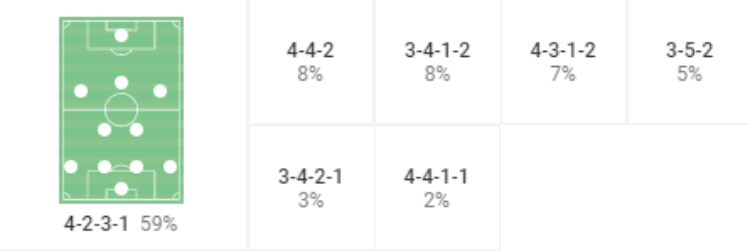
Next, we will look at their tactics in all four phases of the game, starting with their own possession phase.
Controlled and structured build-up with variability in the final third
The build-up patterns and offensive qualities are probably the aspects of Ried which helped them the most to get promoted. They scored 73 goals in 30 league games and FC Liefering (RB Salzburg’s second squad) is the only team in the league to also score that much.
Interestingly, Baumgartner’s squad has four players who scored in the 2019/20 season at least nine goals. No other team in the league has four men who managed that so Ried have not just one offensive player to rely on but several players in the squad who are very dangerous in the final third. Jefté Betancor, Marco Grüll, Julian Wießmeier and Bernd Gschweidl are the four players who all scored at least nine times. However, before we look at their ways to create goalscoring chances, we will focus on the progression of the ball.
Basically, their 4-2-3-1 starting formation turns into a kind of a 3-4-1-2/3-4-2-1 in possession and especially the positioning of the five central men further up the pitch is very fluid. To create this structure, one defensive midfielder (mainly Marcel Ziegl) drops between the two centre-backs who split wide and the full-backs stay near the touchline and push forward. The wingers tuck in and the number 10 drops to be about on the same height as the other defensive midfielder. In the image below, we can see this structure.
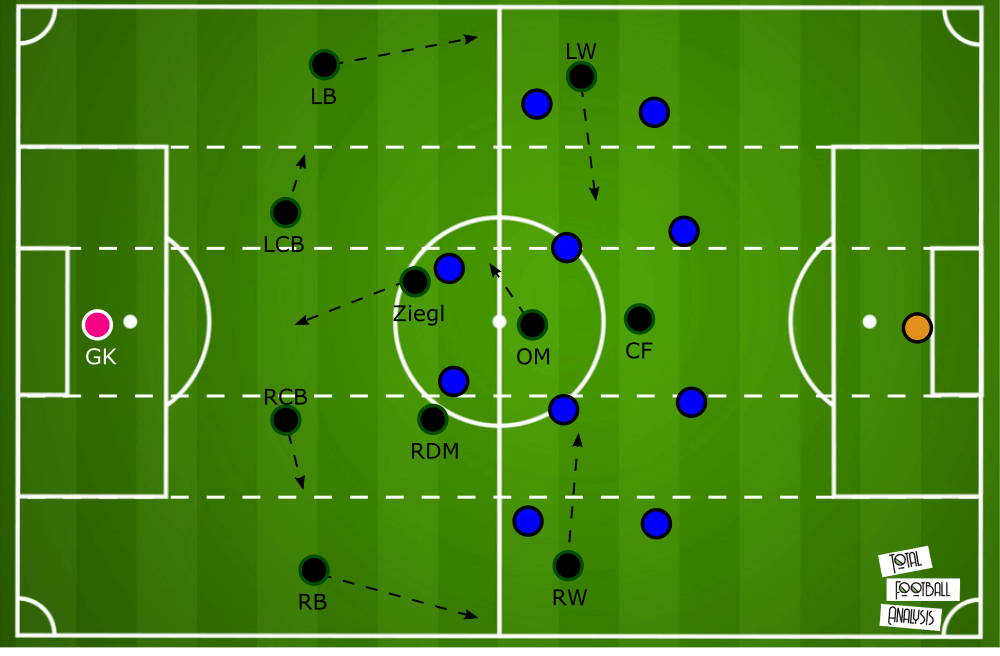
At this point, it is important to note that the wingers not necessarily always completely tuck in and that this is more of a tendency. Especially Jefté and Grüll also often stay on the wing, but only when the respective full-back is not positioned that high up the pitch. This is done to avoid occupying the same space.
Also, the positioning of the offensive midfielder, the two wingers and the striker is basically very flexible and the main idea is that they are in different vertical and horizontal zones to open up passing lanes.
Baumgartner wants his team to have the control of the game when possible, but is also happy to let the opposition dominate and will sit back deeper as we will see later again in this tactical analysis. However, when they are in possession, they focus on having a structured and organised circulation of the ball via short passes.
Due to that, the positioning of the five central men is important as they should provide the deeper men as many vertical or diagonal passing options as possible while the full-backs provide the width and should stretch the opposition.
The central defenders who are during the possession phase in the half-space are encouraged to dribble forward when the option occurs. When going forward with the ball at their feet, like in the following example Kennedy Boateng does, the full-back of the opposing side stays deeper to have enough men at the back in case they lose the ball.
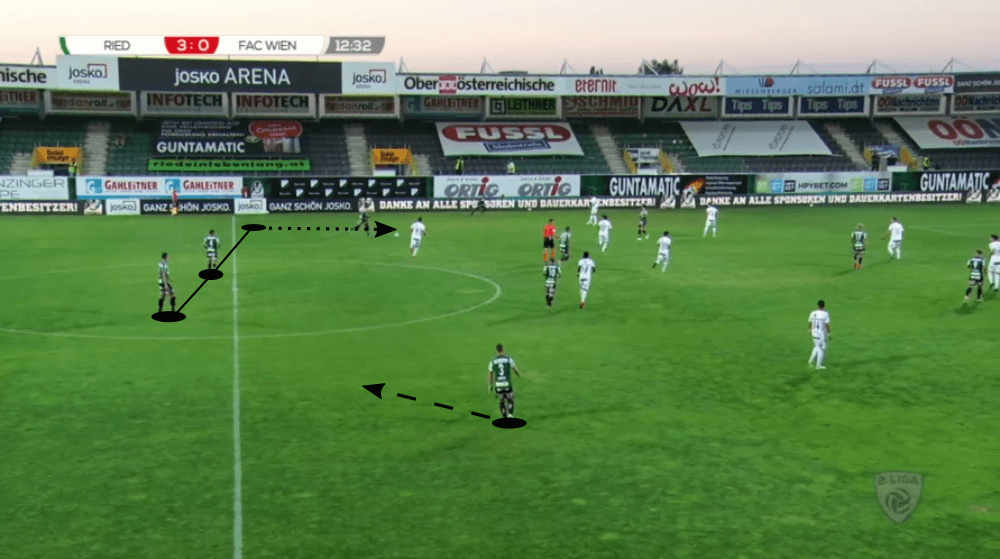
As already noted earlier in this tactical analysis, a central idea in the philosophy of Baumgartner is to always have enough bodies in the centre. This is quite similar to RB Salzburg who showed recorded some great performances with similar tactics last season in the Austrian Bundesliga and the UEFA Champions League against the likes of Liverpool or Napoli. Baumgartner was for several years at RB Salzburg and that might have influenced the way he thinks about football today.
An important reason for the central positioning of so many players is to have enough options for follow-up action as soon as the ball gets played into the centre. They want to enter the final third via line-breaking balls and the receiver upfront should then have enough teammates around him to have little interplays with them.
These little interplays serve the purpose of keeping possession in the final third but are also a central idea in Ried’s tactics to bring players in positions from where they can shoot, as we can see in the example below.
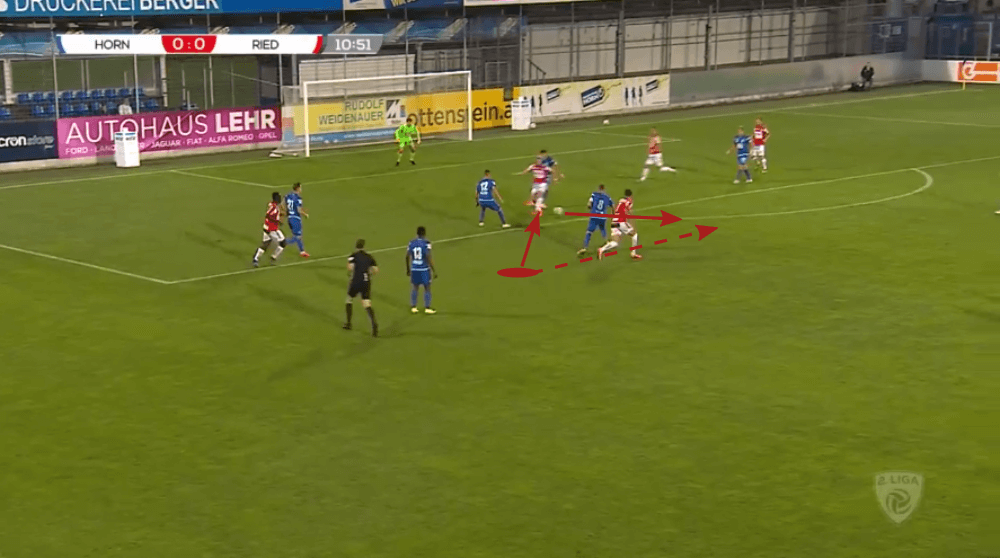
Apart from these give and goes, Baumgartner also wants his players to permanently target the space behind the last line of the opposition’s defence. The offensive players (especially the tucked-in wingers and the striker) should make runs behind the defence of the opponent and then their teammates should find them with through passes.
In the shot below, we can see a perfect example of that as the left-winger Grüll starts a diagonal run from the centre behind the opponents. This is done so he can receive a through pass which he then lays off for his teammate Gschweidl who subsequently scores the goal for 4:0.
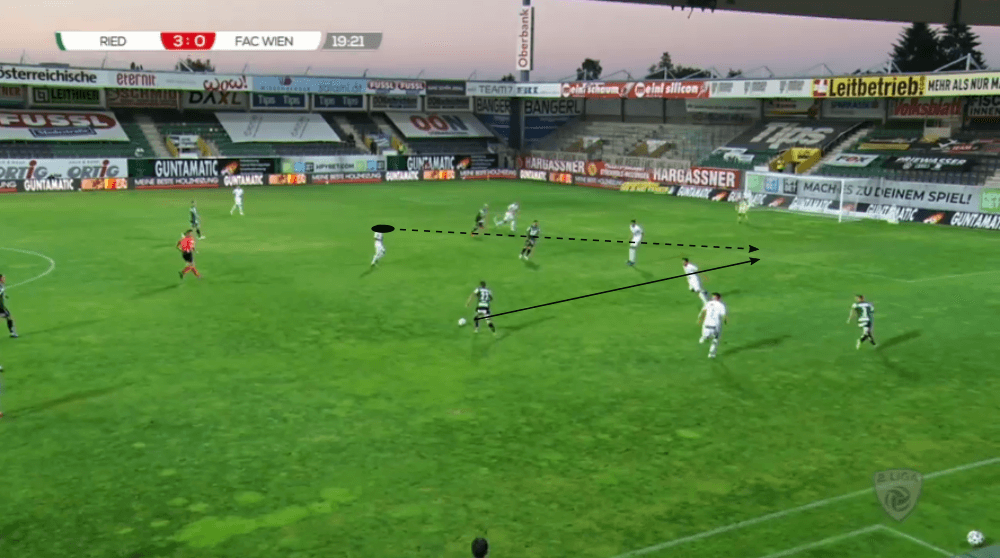
However, a central strength of Baumgartner’s side is that they are not just dangerous when it comes to their attacks through the centre since they still have their full-backs who can also be very dangerous in the wide-areas.
However, while RB Salzburg’s wide-defenders were often successfully isolated by the opposition (especially the Bundesliga side Frankfurt did this well in the UEL), the central players of Ried always try to support the full-backs. This then often leads to situations like the one below where they overload the wing to avoid that the wide-defender is alone against several opponents.
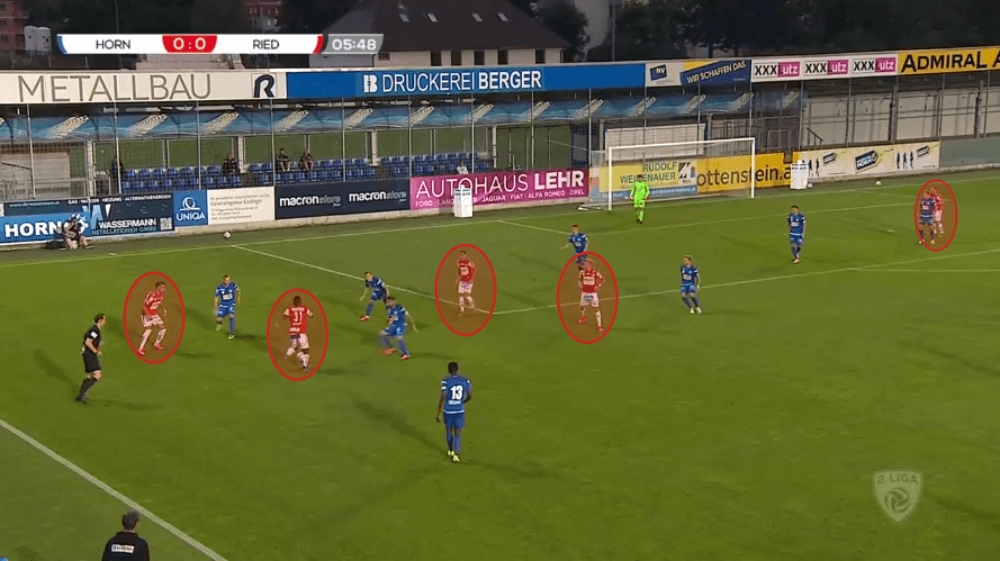
In those situations, a cross is logically completely senseless since there are only one or two options in the centre as we can also see above. However, there are also situations when the offensive full-back receives support from only one or two teammates which means that they have enough bodies in the centre to deliver a cross. The players of Ried are very intelligent when it comes to their crossing game since they only bring in deliveries when there are really enough options like in the example below.
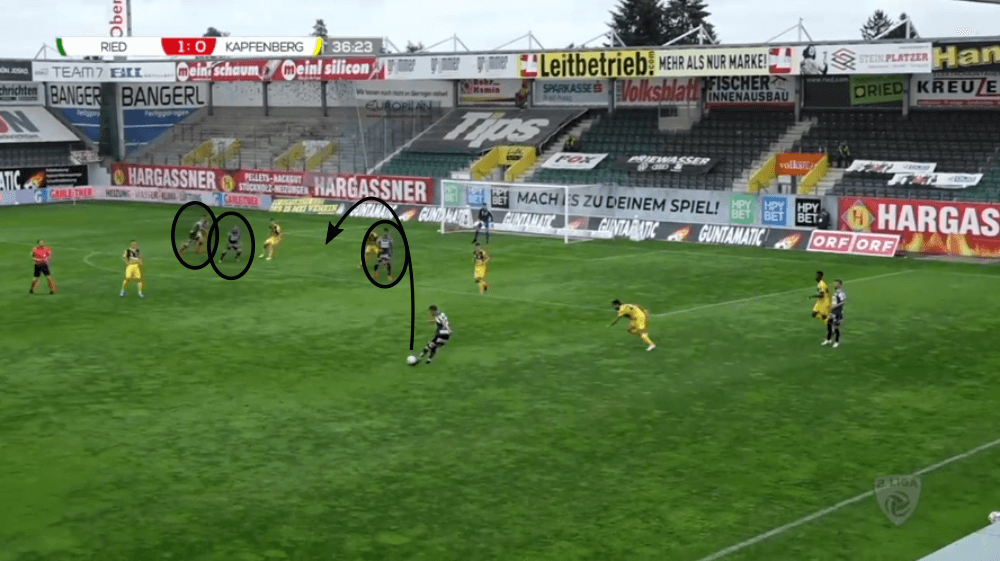
Counter-pressing
Another central aspect of Baumgartner’s philosophy is the counter-pressing as soon as the team loses the ball. The goal in those situations is to win back the ball as soon as possible to give the opposition not even a chance to start a counter-attack.
To do so, Ried act very man-orientated and at least one player immediately puts pressure on the opponent on the ball. In those situations, they take a lot of risk since the defenders are also encouraged to help during the counter-press. The goal is to cut off all short passing option via the man-orientation and to additionally put pressure on the ball-carrier from several directions. In the shot below, we can see an example and note that even the left centre-back Boateng pushes forward to help his teammates.
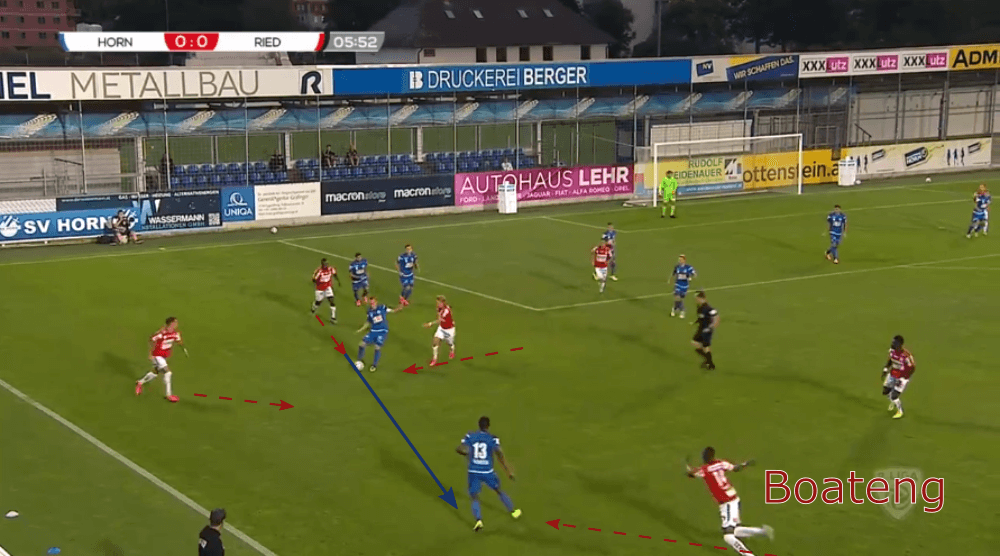
Switching between different tactics out of possession
When the first few seconds after the loss of possession are not enough to win back the ball, we enter the possession phase of the opposition in which Baumgartner uses different tactics. Neither do they put pressure on the opposition high up the pitch throughout the whole 90 minutes nor do they sit back deeper for the whole game. This variability in defence is a central strength of their team. While several high recoveries with the aid of the press led to some goals last season, they were also often successful in counter-attacks as they had a lot of space to exploit since they lured in the opposition during the possession phase.
Ried are very flexible during the possession phase as well as when they are out of possession, but they always want to have the game in their hands. Even when they sit back, as we can see in the example below, they are still trying to be active. Football fans often think that a low or middle block has instantly something to do with a passive style of play but Ried are the perfect example of the contrary.
When they decide to let the opposition have longer spells of possession, they mainly use a 4-4-2 structure as the offensive midfielder positions himself next to the striker and the two wingers drop on the same height as the central midfielders. They then put pressure on the opposition at about the height of the halfway line. We can see an example below.
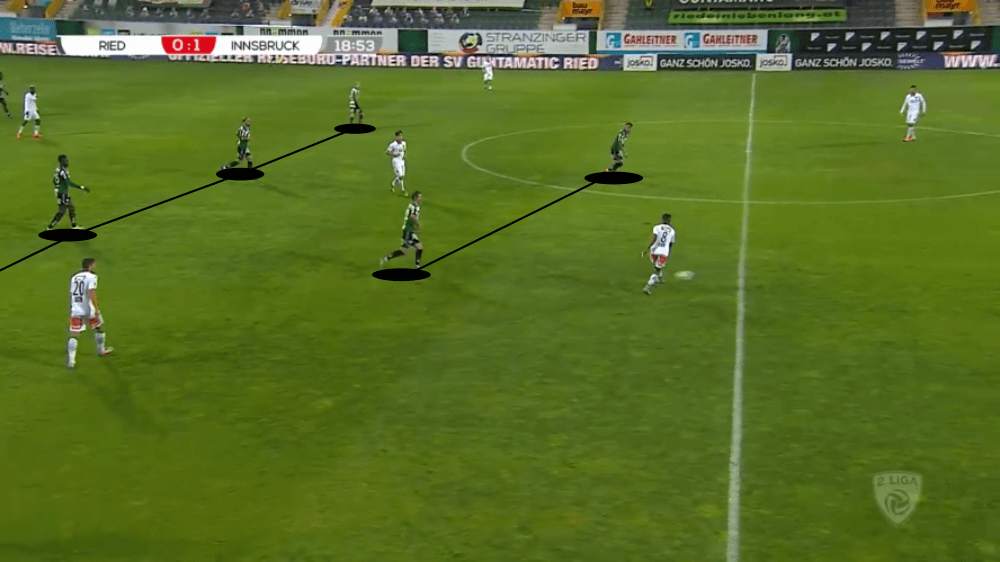
However, as mentioned earlier in this tactical analysis, they do not just sit back and wait for the opposition when they are out of possession, but we can also often see them executing a high and aggressive pressing.
In those situations, they once more act very man-orientated and we can also often see the typical pattern that their striker uses, which is a curved run to force the centre-back to the outside and provoke the pass to the full-back who will instantly receive pressure from the winger. Meanwhile, the whole team pushes forward to man-mark the opponents and the striker with the curved run already acts so aggressive that he not just tries to provoke the pass but also goes for the recovery by himself.
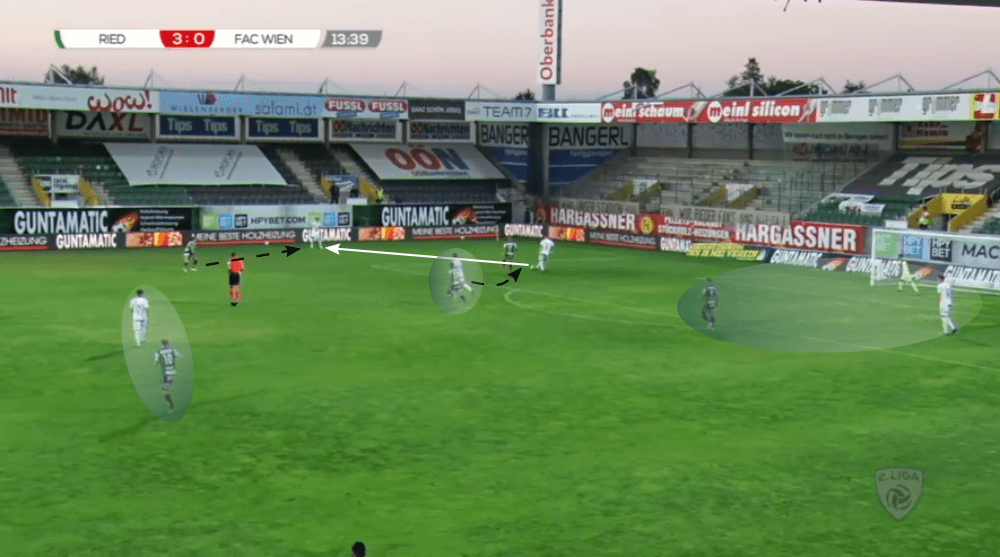
However, even though Ried were in the recent season often successful with these tactics and made high recoveries, some teams found an efficient way to overcome this press: long switches. Baumgartner’s side often shifts to the side where the ball is located to create numerical equality or even advantages around the ball. This completely frees the other side of the pitch.
Some opponents then go for the diagonal or horizontal switches to exploit this free space and then play forward on this side as we can see below.
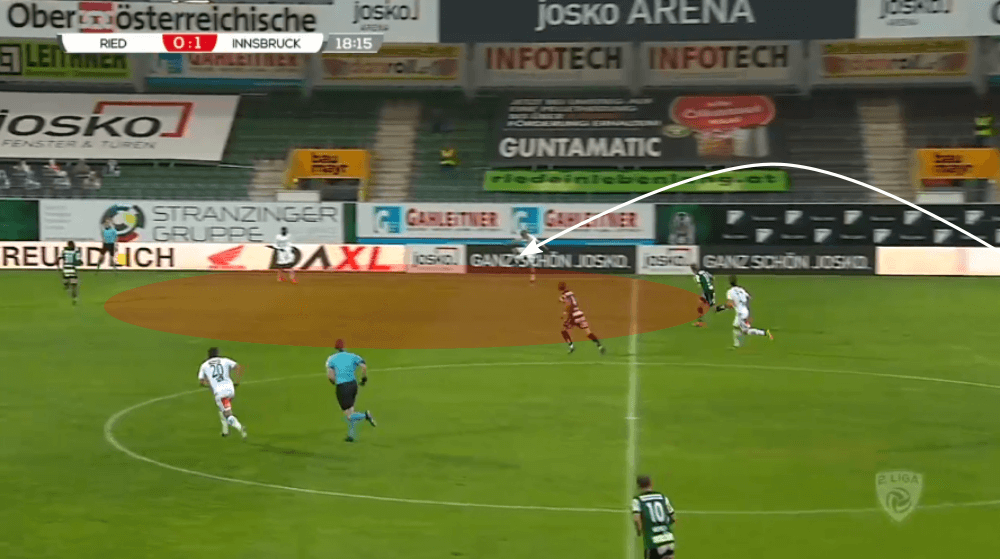
Basically, the wide-areas are the spaces where Ried are the most vulnerable. Firstly, theses long balls from one side to the other are probably the most efficient way to overcome the press and secondly when they sit back a bit deeper, we can often see that opponents in the wide-areas have too much space due to the narrow and too high positioning of the wingers. Therefore, the wide-areas are where a team can really hurt Baumgartner’s side.
Verticality after the recovery
Another central aspect of the philosophy of Baumgartner is the vertical style of play as soon his team are able to win back the ball. He expects from his players to very quickly get the ball forward during the offensive transition to give the opposition no time to start the counter-press or get back into their defensive formation.
Since Ried have several players with a lot of pace, these counter-attacks are often very dangerous and due to that, it makes sense that Baumgartner’s team sometimes sits back during the defensive phase to lure in the opposition and then have more space during the offensive transition.
Basically, there are two main principles which are important to understand the way that Ried try to attack during the offensive transitions: They want to create vertical passing lanes with the aid of diagonal and vertical runs plus Baumgartner wants to see that as many players as possible rush forward to have enough players upfront. Below, we can see an example for the first principle as they create a vertical passing lane during the early stage of the counter-attack to get forward as quickly as possible.
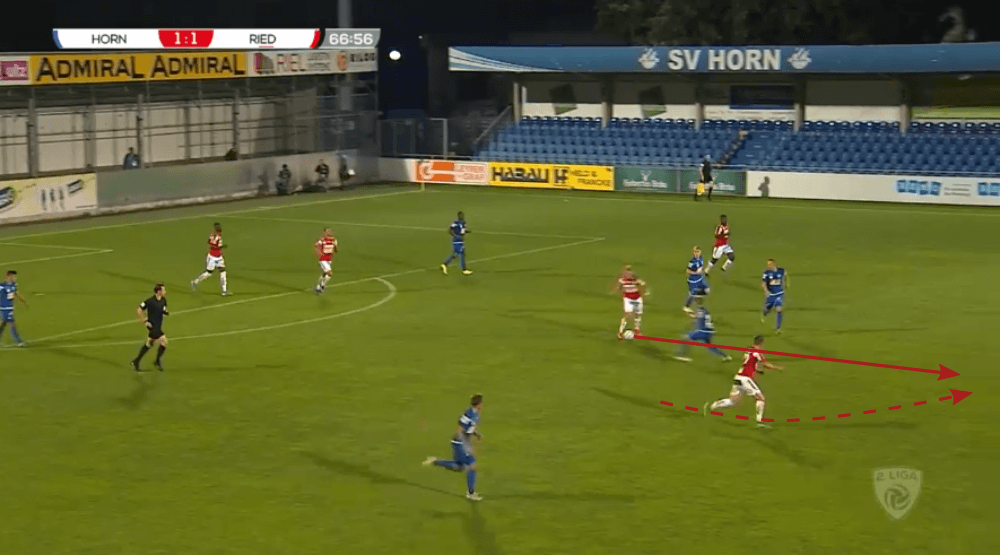
These movements and progressive passes logically then also can be seen in the final third to actually create the goalscoring chance. The second central aspect of their counter-attacks is to rush forward with several players which then gives them more options as soon as they reach the final third.
This is logically very exhausting for the players, but also often pays off. We can see an example below as only a few seconds after the recovery in the own half, there are already five players in the final third.
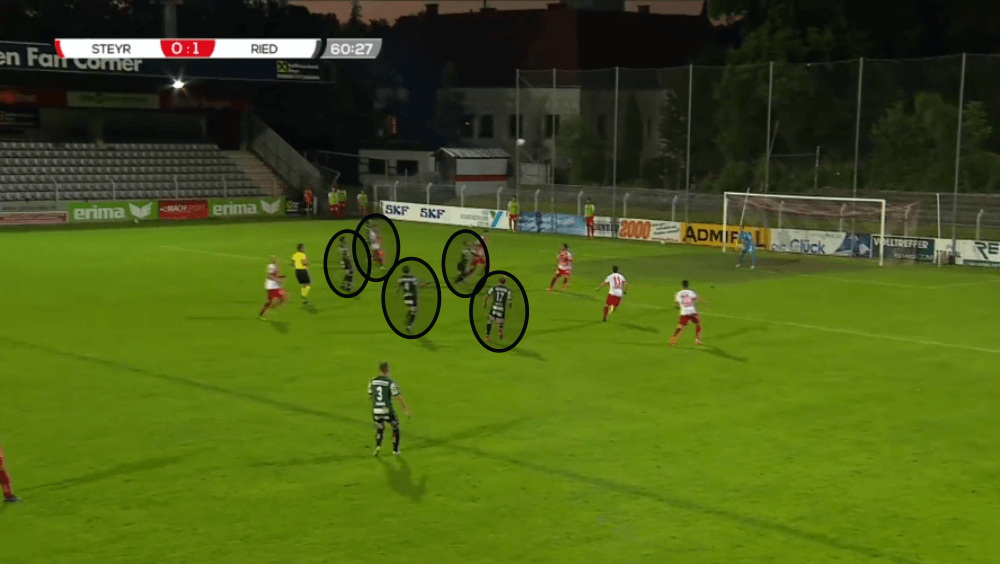
Conclusion
Basically, we can conclude the tactics and philosophy of Baumgartner by just saying the word active since they want to avoid passiveness in every single phase of the game and want to control the opposition even out of possession.
Since even Baumgartner confirmed that they would have almost no financial backing, there won’t be any big transfers in the summer transfer window which means that they will start the upcoming season with a squad with about the same quality as they had in the 2019/20 campaign. Therefore, it will be interesting to see how they perform in the Austrian Bundesliga and if they adjust their style of play in any way.





Comments